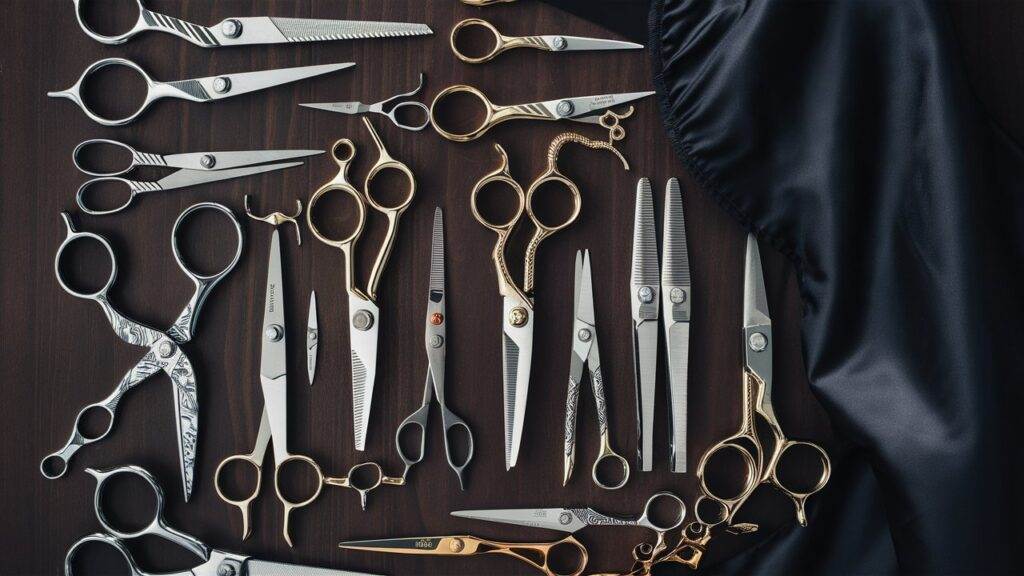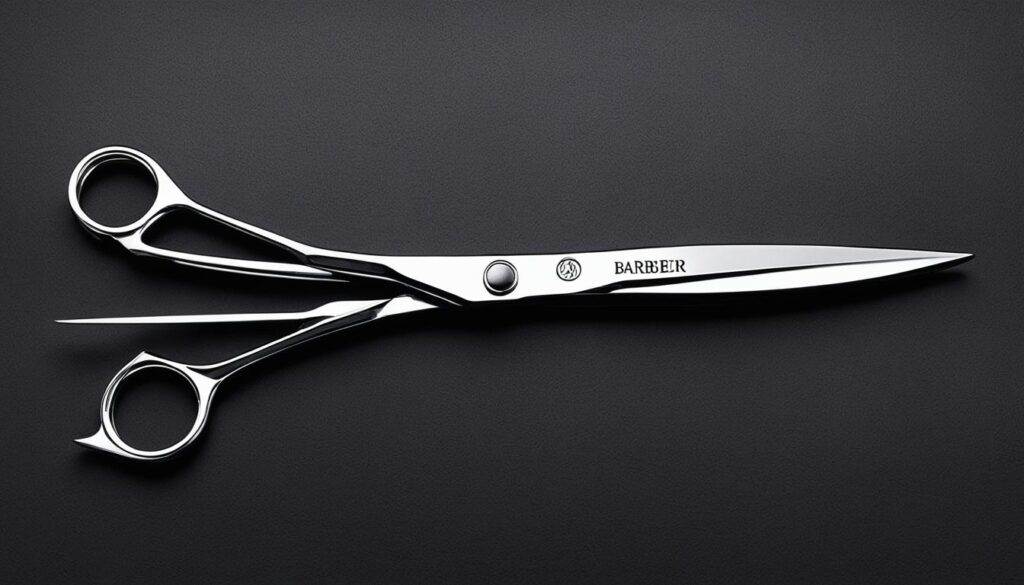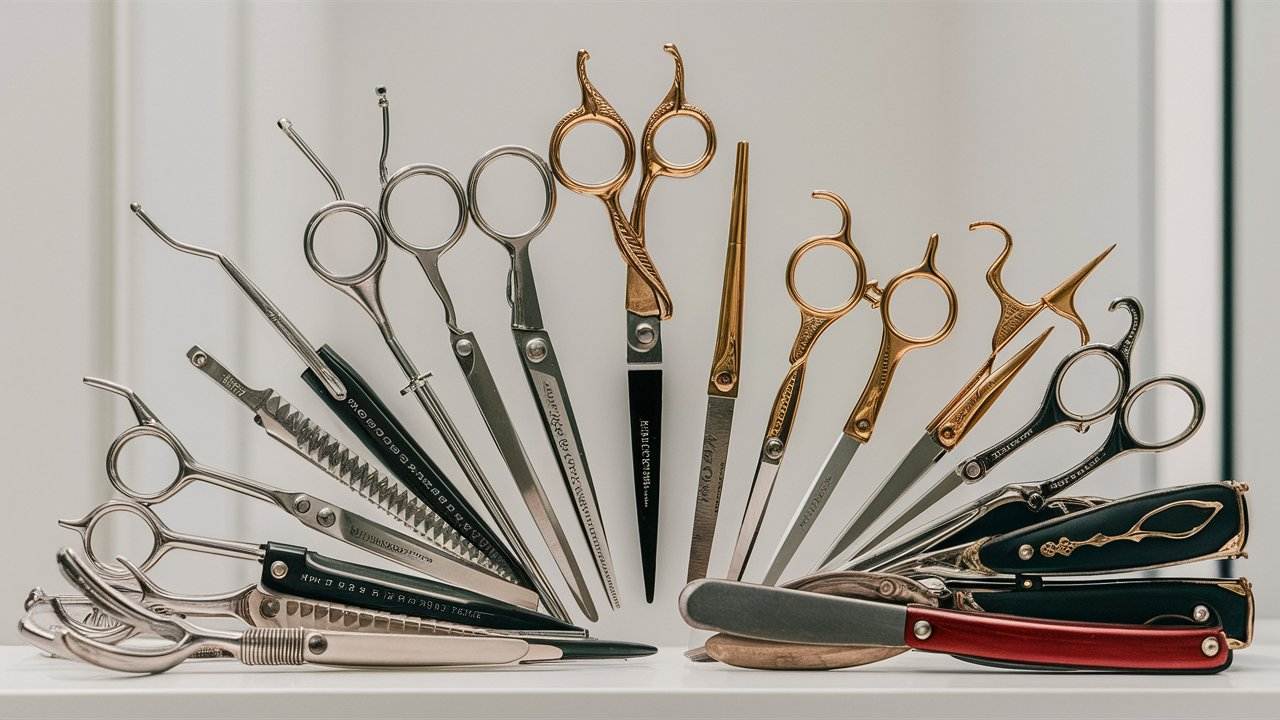Barbers rely on various types of scissors, including hair cutting tools like hairstylist scissors, professional shears, and salon scissors to achieve that perfect cut. These essential barber tools are integral parts of any hairdressing kit to ensure precise haircuts.
The Basics of Hairdressing Scissors and Shears
What Are Hairdressing Scissors?
Hairdressing scissors, or barber scissors, are special tools made for cutting hair. These professional hairdressing scissors help hairstylists create different styles by cutting, thinning, and layering hair. Over time, these tools have changed a lot. They went from simple blades to high-quality shears made from strong materials like Japanese steel and stainless steel. Knowing this history helps barbers see the skill that goes into making modern scissors.
Why Are High-Quality Scissors Crucial for Barbers?
High-quality barber scissors are super important because they affect how well a stylist can work. With good professional barber scissors, stylists can make clean cuts and detailed styles that keep clients happy. Plus, using better tools helps keep hair healthy by cutting down on split ends and damage during the haircut. Buying high-quality scissors means they last longer and work better in busy salons.
Essential Features to Look For in Barber Scissors
When picking out barber scissors, there are some key features to think about:
Scissor Material: Look for materials like stainless steel or Japanese steel since they’re tough and stay sharp.
Blade Types:
- Convex Edge: This type is great for smooth cuts and precision.
- Bevelled Edge: This one is more flexible for different cutting styles.
Handle Designs:
- Offset Handle: This design helps reduce wrist strain while cutting.
- Swivel Handle: It lets you move your hand easily during cuts.
- Opposing Handle: A traditional style that gives you stability.
Knowing these features can help barbers choose the right tool that fits their style.
Common vs. Professional Haircutting Tools
There’s a big difference between common haircutting tools used at home and professional-grade shears. Salon-grade scissors are built for performance with sharper blades that give cleaner cuts. They also have designs that make them comfortable to use for long periods without hurting your hands. On the other hand, home-use scissors often aren’t precise or durable enough, which can lead to bad results and even damage hair over time. That’s why it’s smart for professionals to invest in high-quality tools that meet their needs.
Different Types of Hairdressing Scissors
Short-Bladed Cutting Scissors
Short-bladed cutting scissors are super important for getting precise cuts in hairdressing. These short-bladed scissors help you make detailed cuts and sharp lines. Barbers love using them for those finishing touches around the ears and neckline. When picking out short-bladed scissors, it’s smart to choose ones made from high-quality materials like stainless steel or Japanese steel. This way, they stay sharp and last a long time.
Pros:
- Perfect for detailed work.
- Easy to use in tight spots.
Cons:
- Not great for bulk hair removal.
- Limited to certain cutting styles.
Long-Bladed Barbering Scissors
Long-bladed barbering scissors are made for quick and efficient hair cutting. Known as long-bladed scissors or hair shears, they’re awesome for chopping through bigger sections of hair fast while still keeping control. They work really well for straight cuts on long hairstyles or when dealing with thick hair.
Advantages:
- Great for cutting large sections quickly.
- Saves time while cutting.
Drawbacks:
- Takes more skill to handle properly.
- Can feel heavy if not balanced right.
Wide-Tooth Thinner Scissors
Wide-tooth thinner scissors are key tools for adding texture and volume to hairstyles. Also called thinning shears or coarse hair scissors, they help take away bulk without losing length. It’s best to use these on dry hair so you can see how it looks right away. They’re especially helpful for layered cuts and styles that need some movement.
Blending/Texturizing Scissors
Blending or texturizing scissors are all about creating smooth transitions between layers. These professional barber scissors have special teeth that can give different effects based on what style you want. You can use these shears at an angle to make natural-looking blends without any harsh lines.
Chunking Thinning Scissors
Chunking thinning scissors have wider gaps between their teeth compared to regular thinning shears. This design is great for taking off a lot of bulk from thick or coarse hair while still keeping some length. They work really well for shag cuts or heavily layered styles where you want less volume.
Convex Edge Hair Cutting Shears
Convex edge hair cutting shears are known for being super sharp and smooth because of their curved blade design. These shears shine in precision techniques like blunt cuts or slide cutting. To keep them working well, it’s important to have them sharpened by a pro regularly.
Bevelled Edge Hair Cutting Shears
Bevelled edge hair cutting shears balance durability with versatility, making them good for different hair textures. While they can handle many styles, they may need sharpening more often than convex blades because of their design features. Taking care of them helps ensure clean cuts across various hairstyles.
Understanding the types of barbering scissors is really helpful if you’re looking to improve your skills and toolkit as a stylist or barber! Each type serves its own purpose that adds a lot to hairstyling, helping barbers meet all kinds of client needs with confidence and skill!

Advanced Hairdressing Shears- Handles and Ergonomics
Importance of Ergonomic Designs
Ergonomic designs in hairdressing shears are super important for barbers who spend long hours cutting hair. These ergonomic scissors help reduce strain on the hands and wrists, lowering the risk of injuries like Carpal Tunnel Syndrome. With a comfy grip, these scissors cut down on hand fatigue, letting barbers keep their precision and efficiency all day long. Investing in comfortable hairdressing scissors can really boost a barber’s performance and job satisfaction.
Offset Handle Scissors
Offset handle scissors are made to create a natural hand position while cutting. This design helps with better control and less wrist strain during long use. Many professional barber scissors have this offset handle design to fit different cutting styles. Barbers should check out models that offer adjustable tension for even more comfort and precision.
Swivel Handle Scissors
Swivel handle scissors come with a rotating thumb ring that lets the thumb move freely while cutting. This flexibility helps barbers reach different cutting angles without straining their wrists. Great for detailed styles or intricate work, swivel scissors can really improve both cutting speed and comfort. Barbers might want to add these advanced hairdressing scissors to their toolkit for extra versatility.
Opposing Handle Scissors
Opposing handle scissors are one of the oldest designs in hairdressing tools. They offer great balance and control but might not be as comfy for long periods compared to ergonomic options. Still, many experienced barbers love them for their classic feel and function. Knowing when to use opposing handle shears versus newer styles is key to getting the best results in various barbering techniques.
Crane Handle Scissors
Crane handle scissors have an angled grip that helps keep the wrist in a neutral position while cutting. This ergonomic advantage reduces stress on the wrist, allowing barbers to make precise cuts easily. Many top-quality barbering tools include this design feature because it really boosts user comfort over time.
Forward Set Thumb
Forward set thumb shears have a special design where the thumb sits ahead of the fingers on the handles. This setup gives more leverage when making cuts, which can lead to better precision in hairstyling techniques like blunt-cutting or texturizing. Barbers looking for high-performance scissors should think about these shears since they offer unique benefits compared to traditional designs.
By understanding these advanced features of hairdressing shears—especially regarding handles and ergonomics—barbers can choose tools that fit their needs while boosting both performance and comfort in their craft.
Specialized Scissors for Different Hairdressing Needs
Thinning/Texturizing Scissors
Thinning and texturizing scissors are must-have tools in a barber’s kit. These special shears help remove bulk from hair while keeping the length, making them great for layered styles or softening sharp lines. When using thinning scissors, hold them at an angle and work through sections of hair carefully.
Start at the ends of the hair and gradually move up. This way, you can evenly spread out the texture. This technique is especially helpful for clients with thick or coarse hair who want a lighter feel without losing length. Using professional barber scissors well can really improve your hairstyling skills.
Scissors with Wider Teeth
Wider-tooth thinning scissors are made just for coarse or thick hair types. The wider teeth let you take off more bulk while giving a softer finish than regular thinning shears. They’re often used to add volume to hairstyles or to lighten heavy locks.
When using these scissors, focus on larger sections of hair and use gentle pressure to avoid uneven cuts. These tools are super handy when working with curly or textured hairstyles where every cut counts!
Barbering Scissors with Long Blades
Long-bladed barbering scissors are popular among professionals because they work well for removing bulk and making precise cuts. They shine during blunt cuts or when creating straight lines in longer hairstyles.
To get the most out of long-bladed scissors, keep your hands in the right position and cut at angles that match your client’s head shape. This helps create smooth changes between different lengths and styles while ensuring each cut is accurate.
Scissors for Blending and Layering
Blending and layering are key skills in modern hairstyling that need specific scissor types designed to create smooth transitions between lengths. Barbers should use blending shears that have both regular blades and teeth to get this effect just right.
For seamless blends, section the hair into manageable parts and apply the shears at different angles. This will create movement without harsh lines. Many professionals suggest practicing on mannequin heads before cutting real clients to master these important skills.
Customization- Detachable Finger Brace and Tang
Customization features like detachable finger braces and adjustable tangs can really boost comfort when using barbering shears for long periods. These options let barbers adjust their tools based on personal preference, helping reduce hand fatigue over time.
Knowing how these adjustments impact grip and control is key during cutting sessions. Regularly checking these components ensures everything works smoothly whenever you pick up your scissors.
Understanding different specialized types of scissors used by barbers is important not only for getting desired styles but also for improving client satisfaction overall. Each type has its own purpose; mastering their use will greatly help develop advanced haircutting techniques that are vital in today’s competitive environment.

Maintenance and Care for Longevity
Why Do Scissors Get Rusty? The Science Behind Rust and Stainless Steel
Hairdressing scissors can get rusty when they come into contact with moisture or if they are not cared for properly. Even though stainless steel is used in high-quality scissors because it resists rust better than other materials, it can still corrode without the right maintenance.
Rust mainly forms due to three things: water, humidity, and salt or chlorine. When scissors touch these elements, they might start to oxidize, leading to rust.
To keep rust at bay, barbers should dry their scissors well after each use. It’s also important to store them in a dry place. A few drops of oil on the blades create a protective layer against moisture and greatly lower the chances of rust forming.
Best Hair Scissor Sharpening Services
Keeping hairdressing scissors sharp is key for great performance. Dull blades can cause split ends and uneven cuts, which won’t make your clients happy. That’s why professional sharpening services are a good idea; they use special tools that keep the blade’s edge intact.
When looking for a sharpening service, here are some tips:
- Experience: Choose services that focus on high-quality barber scissors.
- Reviews: Check out what other customers say about them.
- Recommendations: Ask fellow barbers who they trust for sharpening.
Finding the right professional sharpening service will help your scissors stay sharp and ready for all your cutting needs.
Cleaning and Sanitization Tips
Cleaning your hairdressing scissors is super important—not just for keeping them in shape but also for hygiene. After each use, wipe down the blades with a soft cloth to get rid of any hair products or debris.
For deeper cleaning:
- Soak the blades in warm soapy water.
- Use a soft brush to gently scrub off any leftover residue.
- Rinse under running water thoroughly.
- Dry them immediately with a clean cloth to stop moisture from building up.
Following this cleaning routine will help keep your tools sharp and hygienic, ensuring both longevity and client safety.
Storage Solutions to Protect Your Investment
How you store your barbering scissors matters a lot! Using a scissor case or pouch keeps them safe when not in use.
Here are some storage tips:
- Cool Environment: Keep your scissors in a cool, dry place away from sunlight or extreme temperatures.
- Avoid Drawers: Don’t just toss them into drawers where they could get nicked by other tools.
- Scissor Cases: Invest in good-quality scissor cases that cushion and protect against bumps.
By following these storage solutions, you can extend the life of your hairdressing tools while keeping them ready whenever you need them.
Taking care of your hairdressing tools through regular cleaning, professional sharpening services, understanding how to prevent rusting, and proper storage will greatly improve their longevity and performance in your barbering practice.

